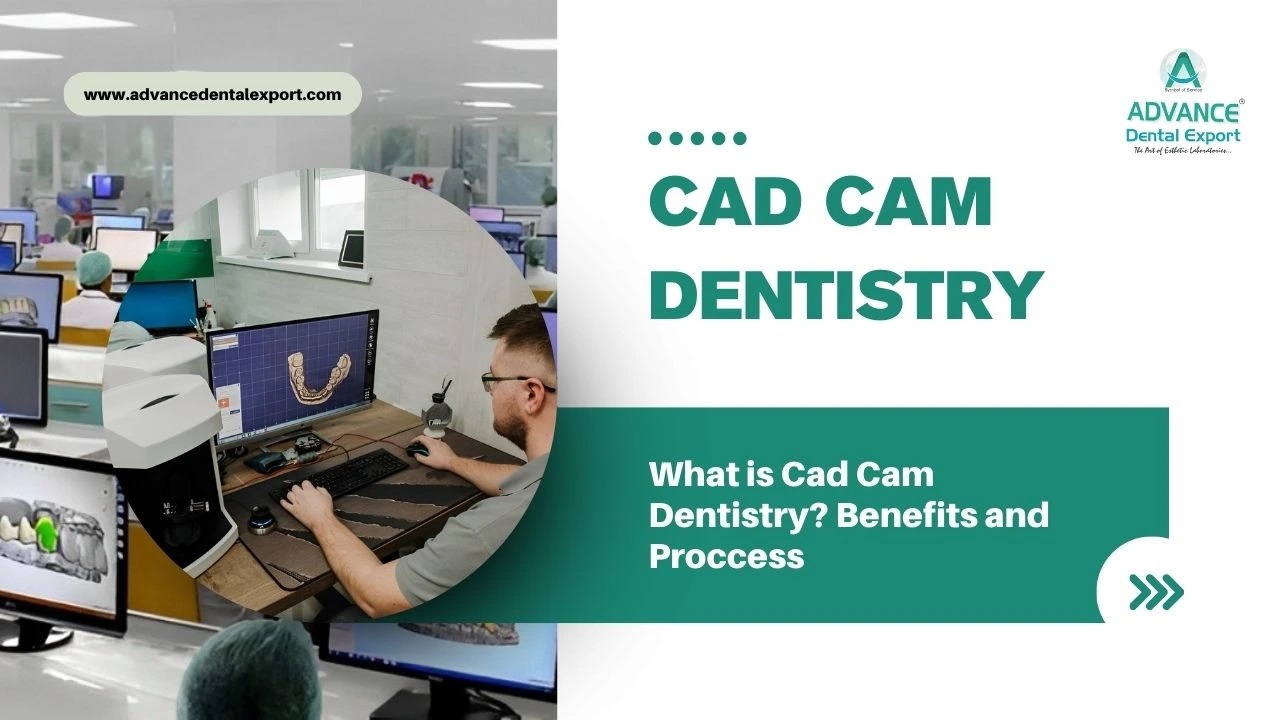Importance of CAD/CAM in Dental Laboratory for Precision

Strong 8k brings an ultra-HD IPTV experience to your living room and your pocket.
In today’s fast-changing world, technological advancements are touching every aspect of our lives. The dental industry is no exception. Traditional dental labs, where most of the work was done manually, have now been revolutionized by CAD/CAM (Computer-Aided Design/Computer-Aided Manufacturing) technology. This is not just a new method, but a powerful means to bring precision in dental restorations and completely transform the patient experience.
As an expert dental professional, I will give you an in-depth understanding of the importance of CAD/CAM in dentistry, its benefits, and how it is shaping the future of dental labs. Let’s see how this amazing technology saves time, reduces human errors, and increases patient satisfaction.
What is CAD/CAM? - The Foundation of Technology
The meaning of the term CAD/CAM in dental is very simple to understand:
CAD (Computer-Aided Design): This refers to software and systems that allow dental professionals to digitally design dental restorations such as crowns, bridges, veneers, implant abutments, and dentures. In this, 3D scans of the patient's teeth are taken, and then the teeth are virtually created on a computer screen.
CAM (Computer-Aided Manufacturing): Once the design is ready, the physical object of that design is created using a CAM system. This is usually done by a milling machine that precisely carves the dental restoration from a solid block.
Traditionally, dental restorations were made through manual modeling, waxing, and casting processes. These processes were based on artistry and experience, but had limitations in time, human error, and accuracy. CAD/CAM has removed all these limitations and brought dentistry into the digital age.
Revolutionary Importance of CAD/CAM in Dental Laboratory
CAD/CAM is not just a convenience for dental labs; it is a game-changer. Let us understand its key important aspects in detail:
1. Unprecedented Increase in Precision
The biggest advantage of CAD/CAM is its unmatched precision.
Digital Precision: Manual modeling has the limitations of the human hand, while CAD/CAM systems provide precision at the micron level. From the 3D scan of the patient’s mouth to the milling of the final restoration, every step is controlled digitally.
Fit and Function: As a result, crowns, bridges, or veneers fit better in the mouth. This improved fit means less stress on the tooth structure, which helps in the long-term longevity of the restoration.
Marginal Accuracy: CAD/CAM systems achieve excellent accuracy at the margins of the restoration (the edges where the tooth and crown meet). This reduces gaps where bacteria can accumulate, which reduces the risk of future decay or gum problems. This directly increases patient satisfaction.
2. Streamlining Workflows
CAD/CAM technology makes dental lab operations more efficient and streamlined.
Process simplification: Manual processes have many complex steps, while CAD/CAM simplifies them. From taking impressions to designing and milling, the entire process is digital.
Less human labor: The need for manual waxing, investing, and casting is eliminated, which saves lab technicians time and allows them to focus on more complex tasks.
Automation: The milling process is automated, which reduces operator dependency and ensures consistency in production.
3. Time Savings
Time is money, and CAD/CAM offers significant time savings in dental labs.
Faster production: Restorations are produced much faster than traditional methods. In some cases, a single crown can be made in just a few hours, whereas manually it can take days.
Fewer visits: Faster production also means that patients have to make fewer dental visits to receive their final restoration, which is more convenient for them. This is very important for patient satisfaction.
Reduced rework: The high accuracy of CAD/CAM means fewer fitting problems and less need for rework, saving both time and resources.
4. Reduction in Human Errors
Manual processes are always susceptible to human error, no matter how experienced the technician. CAD/CAM greatly reduces this risk.
Objectivity: Since design and manufacturing are software-based, the reliance on individual expertise is reduced.
Repeatability: The system can repeatedly maintain the same high quality and accuracy, which avoids discrepancies caused by human fatigue or error.
Design Review: In CAD software, design errors can be identified and corrected before actual production.
CAD/CAM and Patient Experience - Increased Satisfaction
The benefits of CAD/CAM technology are not limited to dental labs. It also directly benefits patients, who play a key role in increasing patient satisfaction. Here are some of the benefits of CAD/CAM dental.
Faster Treatment: Patients have to wait less time for their dental restorations. In some cases, crowns or veneers can be fabricated and placed in a single visit (Chairside CAD/CAM).
Better Fit and Comfort: Precision-made restorations fit better in the mouth, reducing discomfort and increasing comfort. They do not require frequent adjustments.
Natural Look: CAD/CAM enables the use of state-of-the-art materials such as zirconia that match the color and translucency of natural teeth, resulting in aesthetically appealing and natural-looking smiles.
Less invasive: The digital impression taking process (where scans of the mouth are taken) is much more comfortable than traditional impression trays, especially for patients with gag reflex.
Long-term durability: The use of high-precision and quality materials ensures the long-term durability of the restoration, which reduces costs and hassle for the patient in the long run.
Various Applications of CAD/CAM
CAD/CAM technology is used in dental labs to create various types of restorations:
Dental Crowns and Bridges: This is the most common application. CAD/CAM helps in creating crowns for a single tooth and bridges to replace multiple missing teeth.
Veneers: Thin, custom-made shells that are bonded to the surface of the tooth to correct aesthetic defects. CAD/CAM ensures their precision and thinness.
Implant Abutments: The custom abutments I discussed earlier are created using CAD/CAM, which perfectly connect the implant to the crown.
Full and Partial Dentures: Modern CAD/CAM systems are also used to create parts of dentures or entire dentures with greater precision and comfort.
Orthodontic Appliances: CAD/CAM also plays an important role in the design and manufacturing of orthodontic appliances such as clear aligners and retainers.
A glimpse into the future – CAD/CAM and the future of dentistry
CAD/CAM technology is paving the way for the future of the dental industry. As the technology continues to evolve, we can expect the following changes:
More accessibility: CAD/CAM systems will become more affordable, allowing more dental clinics and labs to adopt them.
More materials: New and improved materials will be developed that can be milled using CAD/CAM, providing aesthetic and functional benefits.
Integration of Artificial Intelligence (AI): AI will be integrated into CAD software, making the design process more efficient, suggesting the best design based on the clinical case, and identifying errors more effectively.
3D Printing: In addition to milling machines, the use of 3D printing technology will also increase in the production of dental restorations (especially models, surgical guides, and denture bases), enabling more complex geometries and customization.
CAD/CAM is not just a tool, it is a platform that enables dental professionals to provide patients with the highest level of care and the best results. It is a promising technology for the future of dentistry.
Conclusion: The Path to Accuracy and Satisfaction
The importance of CAD/CAM technology in the modern dental laboratory is undeniable. It has set new standards of accuracy in dental restorations by overcoming the limitations of manual processes. CAD/CAM has not only made labs more efficient by streamlining workflows and saving time, but has also permanently improved the quality of restorations by reducing human errors.
The end results of this go directly to patients: they receive faster, more accurate, and satisfying results. The role of CAD/CAM in patient satisfaction is crucial, as it provides teeth that look more natural, are more comfortable, and last longer.
As technology continues to evolve, CAD/CAM will become more deeply integrated into the dental industry. Adopting this technology is imperative for dental labs and dentists not only to survive in the competition, but also to provide the best care and quality to patients. CAD/CAM is truly paving the way for the future of dentistry.
Note: IndiBlogHub features both user-submitted and editorial content. We do not verify third-party contributions. Read our Disclaimer and Privacy Policyfor details.


